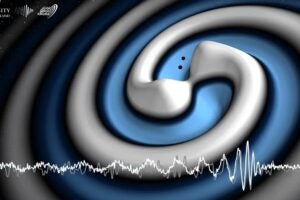AUSTIN, Texas—Is there water on the moon? Researchers at The University of Texas at Austin have designed a quick experiment to find out — crash a retired lunar module into the moon’s south pole, which is believed to contain ice.
UT engineers and an astronomer are teaming up with researchers from NASA-Ames and the Los Alamos National Laboratory to analyze the debris created by the crash and check for evidence of water.
“The discovery of ice on the moon would be of great importance for human exploration of space. Space explorers could separate the ice into hydrogen and oxygen and use it for rocket fuel. They could use the liquid water to build and supply a lunar base,” reasons Professor David Goldstein, a UT Austin aerospace engineer who helped design the experiment, along with Professor Steve Nerem, also a UT Austin aerospace engineer.
Goldstein identified a NASA spacecraft now orbiting the moon called “Lunar Prospector,” whose mission will end this summer when it runs out of fuel and crashes into the moon.
His group has proposed to make Prospector’s end a controlled crash, targeting a crater at the moon’s south pole believed to have ice patches. Using some of the world’s most powerful telescopes, Goldstein’s group can measure the plume of water vapor created by the crash, thereby proving water’s existence on the moon. The crash is planned July 31.
Prospector, as part of its primary mission, clearly detected hydrogen at the moon’s poles. Hydrogen, along with oxygen, make up water, so Prospector found strong, but inconclusive, evidence of water at the poles. Prospector found the hydrogen inside permanently shadowed craters, craters whose floors never see direct sunlight, which would melt any ice.
“It really is a long-shot experiment,” admits Goldstein. “We are crashing Prospector into a permanently shadowed polar crater, which means we cannot see the crash. But we hope to create a barely measurable plume of debris containing ice crystals, dust and water vapor, which will rise out of the crater for a few minutes. In addition, although the moon generally has no atmosphere, we hope the vapor produced by the crash may produce a very thin atmosphere that we can detect several hours later.”
Goldstein’s group is coordinating observations from UT’s McDonald Observatory, the Hubble Space Telescope and the Keck Observatory in Hawaii. NASA has provided preliminary approval for the project, although final approval is pending.
Goldstein’s plan “Impacting Lunar Prospector in a Cold Trap to Detect Water Ice” is to be published in a forthcoming issue of the Geophysical Research Letters and presented at the American Geophysical Union’s spring conference June 1-4 in Boston.
For further information from the following sources contact: American Geophysical Union, Harvey Liefert, 202-939-3212; NASA-Ames, Lisa Chu Thielbar, 650-604-0182. The University of Texas at Austin College of Engineering of maintains a web site at http://www.engr.utexas.edu/



